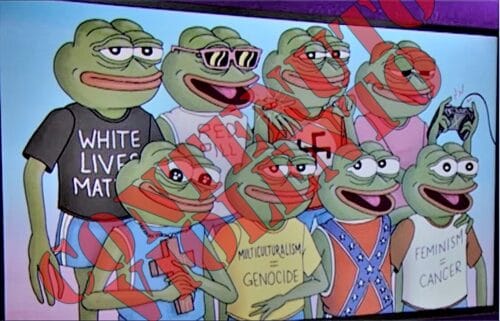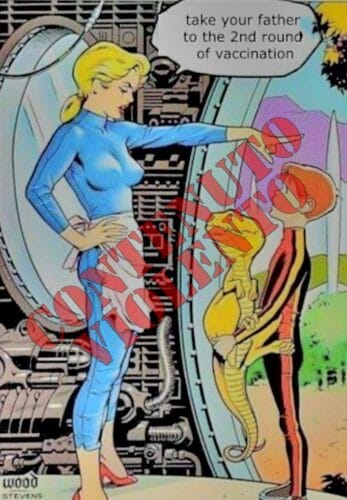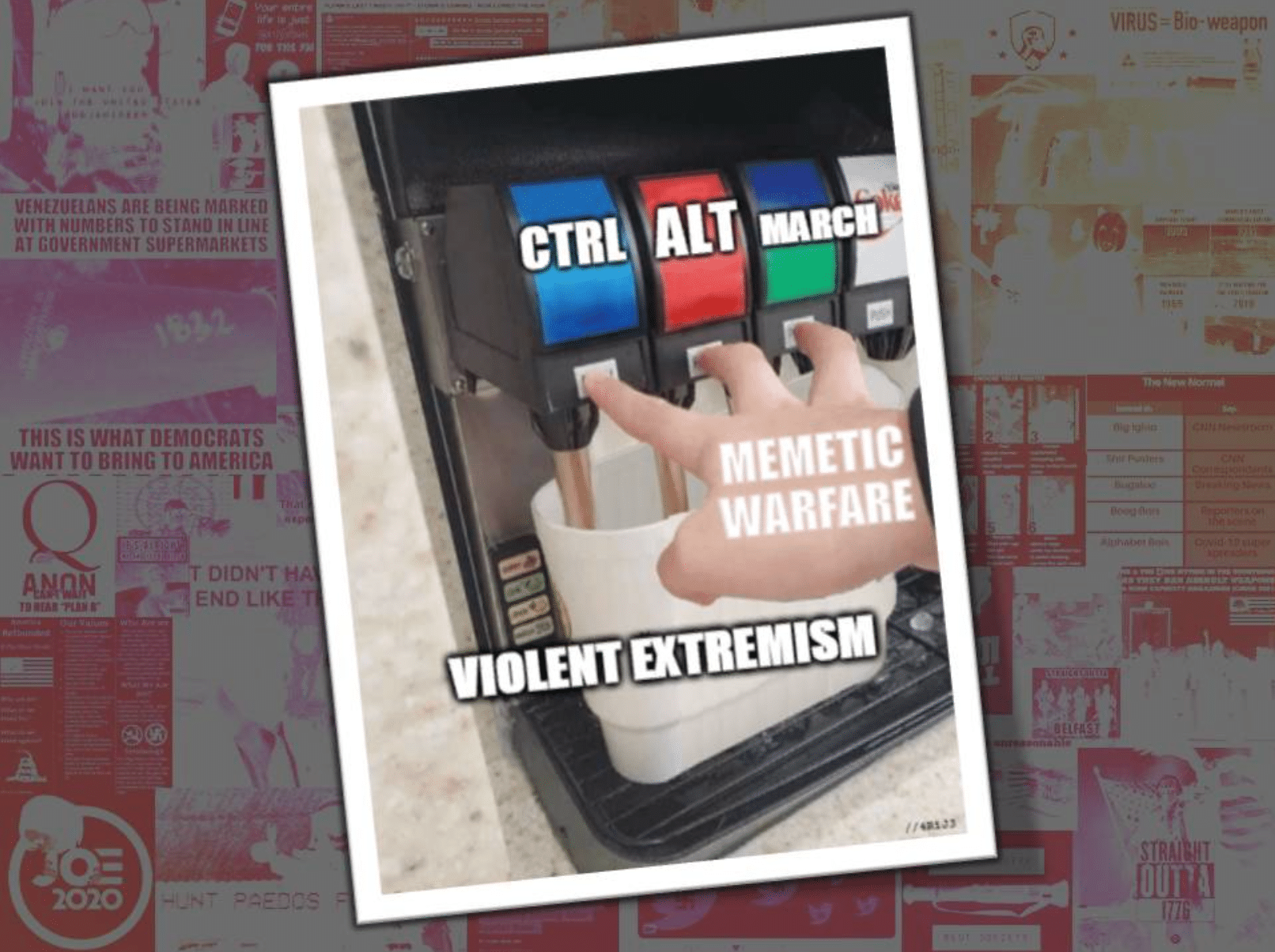The strategic significance of the militarized use of memes lies in their ability to transform citizens into weapons of xenophobic, Islamophobic, anti-Semitic guerrillas, and more generally to instil hatred towards minorities. Social media is where most of the radicalisation happens at the global level, between information warfare and cyberwarfare. The first chapter of the research by Arije Antinori, Professor of Criminology and Sociology of Deviance at the Sapienza University in Rome
***
Warning: the images in this article have been converted to low quality and marked with the “violent content” watermark to prevent further dissemination for propaganda purposes. They are submitted to the readers of Formiche.net for them to visualize the phenomenon studied in prof. Antinori’s academic research. We selected the least shocking and violent ones (so you can imagine the rest)
***
The idea is to create jokes that we can memorize and mass produce.
These strongly need to appeal to emotionality.
We must literally be the hate machine we know.
[Saint Obamas Momjeans, Intermediate Meme Magic, 2016]
During the Trump presidency, we have witnessed the memefication of politics. This has progressively affected the extremist-violent infosphere, driving the US into a scenario of social, cultural and political conflict, the likes of which we have never seen before in the contemporary era.
The images of politicians taking cover among the seats of Capitol Hill during the assault are being used to launch the Make Tyrants Afraid Again slogan – paraphrasing the famous electoral slogan Make America Great Again (MAGA) –, one of the latest violent pro-Trump propaganda meme trends.
INTRODUCTION
In the last decade Pepe the Frog, one of the most popular memes on the 4Chan imageboard, has become the undisputed symbol of extremist alt-right memetics, used to convey stories of xenophobic, anti-Semitic and Islamophobic hatred. Before being shut off, the 8chan, 4chan and Reddit imageboards have been the space-time of “normalization” of the rhetoric and extremist-violent narratives. Through those boards, such narratives have been widely shared on social media, until they “contaminated” the entire (cyber-)social ecosystem by virtue of the massive production and dissemination of memes.

In this land of “creative hatred” even NEET youths – Not in Education, Employment, or Training – can find their “militarized” recognition among the ranks of the memetic guerrilla. The ironic and ambiguous character of memes is the most favourable solution to convey hatred, anger, and ideological violence on a global level. Above all, it can crystallize an extreme vision of the world in a synthetical manner.
Half a century has passed since Marshall McLuhan, in his famous work Culture Is Our Business, stated that the Third World War would be a guerrilla information war, without any distinction between military and civilian participation.
The digital meme is a unit of meaning, a cultural condensate, capable of combining with a similar one, settling, modifying, evolving and replicating in a viral manner, ultimately catalysing the attention of interconnected subjects and engendering an emotional reaction. One of the main traits of memes is that they are perceived by the subject as an “organic” fruit, natural products of the infosphere in which they are disseminated. Thus, the meme is received by the subject with trust and (cyber-)social “intimacy”. The meme is part of the so-called User Generated Contents (UGCs), it is immediate, emotionally effective, simple to package even by using open tools and free online services.

Today we are experiencing a real “memedemic,” the global production and diffusion of memes, partly because of the growth of socio-cultural and political-economic trends of the global crisis. This in turn was caused by the COVID-19 epidemic, which accelerated the growing “radicalization of society” and media weaponization in the post-truth era.
In particular, the strategic scope of the militarized use of memes lies in their ability to directly weaponize citizens, modifying their framing – that is, the process through which, depending on the perspective with which the information is presented, they interpret reality, the existing, the events. The worrying implications in terms of perception/contextualization of information are therefore evident, especially with regards to security issues.
Social (mobile) media, globally, are the main cultivation environment for radicalisation. They provide the platform where information warfare and cyberwarfare converge within a (cyber-)social ecosystem structured around the centrality of the experiential dimension, in the growing perspective of a full “onlife”.

Starting by saying that the concept of “independent platform” is completely inapplicable in the observation of the complexity of the (cyber-)social ecosystem, today Memetic Warfare is one of the most powerful expressions of Fifth Generation Warfare (5GW), especially because of the primacy of the digital ecosystem, the central role of identity and culture, the power of information and narratives and, last but not least, the direct involvement of citizens, since memes embody the exclusivity of the us/them relationship.
This constitutes the element of greatest risk in terms of vulnerability of the democratic system. Memes, which have now become an organic part of Information Warfare strategies and tactics, are used to structure social influence campaigns that aim to induce changes in the behaviour of an increasingly individualized audience.
The ecosystemic and (cyber-)social nature of what today is still superficially defined as “the internet” and “social media” allows for the Memetic Warfare attack plan to expand globally.

By structurally exploiting disintermediation, prosuming (the merging of producing and consuming, editor’s note) and digital emotion on an individual level, Memetic Warfare can capture “hearts and minds.” It can take control of the psychological and social space of narratives, generating multiple, dynamic centres of gravity in which the creativity of the individual becomes the epidemic vector for conducting multidimensional attacks towards specific targets. The multilevel model of memetic diffusion (M3D), structured on Darwinian evolutionism, explains its penetration and diffusion capacity.
Therefore, by contaminating the increasingly digitalized citizen, Memetic Warfare manages to quickly reach the highest dimension of strategic communication – which has always been the exclusive prerogative of governments – soliciting institutional and centralised reactions that can:
- trigger the acceleration of on/offline social, cultural, political and economic conflict;
- b) damage reputation, as the institutional side is inevitably led to intervene, to communicate, among the “marshy sands” of hybrid ambiguity; or even worse, to ignore any external signal, reinforcing within the extremist the perception of censorship and despotism, thereby strengthening their identity, internal cohesion, and narratives.
It is no coincidence that Memetic Warfare is one of the most effective interference strategies wielded by international actors against their competitors. This also happen through the integration with more or less localized astroturfing campaigns (i.e. creating the false impression of a spontaneous, grassroots movement, editor’s note), aimed at manipulating perceptions, polarizing and motivating the audience to act from and within that field.

The advent of digital tribalism around which the (cyber-)social ecosystem has gradually matured has marked the exponential increase in the ability to influence the behaviour of the individual, thanks to the language-culture-organization triangulation. All digital tribes have their own meta-language that shapes reality through the dissemination of seductive narratives that define the socio-cultural boundaries of the infosphere within which one identifies and organizes, in terms of on/offline actions, around to the hypnotic flames of digital propaganda, between knowledge, cooperation and communication.
Since truth is given, in a nutshell, by the encounter, the relationship between mind and facts, it is clear how effective Memetic Warfare can be in redefining reality, especially by finding fertile ground in the society of scandal, shitstorming, violence porn offered through social mobile media, in which information overload and content-consuming compulsiveness overexpose the subject to new vulnerabilities.
The expansive capacity to colonize other territories is one of the main characteristics of the culture war that is fought every day on multiple fronts, where decentralization and disintermediation create the fragmentation of reality into more realities. The result is the mutual inability of memetic tribes to understand each other with regards to the very meaning of conflict, in strategic terms; hence the easy and (un-)mediated tactical-operational convergence on the common target.
1. EXTREMEMISM: MEMETIC WARFARE AND VIOLENT EXTREMISM
In recent years, Memetic Warfare has become one of the privileged means of attack of Racially and Ethnically Motivated Terrorism (REMT), a term grouping the various entities of violent extremism, neo-Nazi and neo-fascist terrorism, now widely (cyber-)socialized. These entities are primarily characterised by xenophobia, Islamophobia, anti-Semitism and, more generally, hatred towards minorities, whom they recognize as the privileged, but not exclusive, target for their violent actions.
In the framework of traditional conflict, camouflage is crucial to the very essence of the asymmetrical entity. Today, by contrast, memetic capacity is an indispensable resource of violent extremism to compete in the (cyber- )social ecosystem, creating and/or strengthening deviant, criminal identities with the aim of acting on the ground, destabilizing and subverting the democratic order, through insurgency.
Extremists use Memetic Warfare to conduct hybrid, multi-domain – mainly the social, cultural, and political –, medium-to-long-range operations across the infosphere, aiming to activating hate propaganda campaigns and targeted violence. They make recurring use of stereotypes to identify, make explicit, label and negatively stigmatize the Enemy, through disinformative narratives – in the sense of artificially shaping reality – of variable depth. Thus, they aim to exponentially expand the spectrum of information disorder, triggering subversive reactive actions, destabilizing and disintegrating communities. Furthermore, because of its nature, Memetic Warfare allows to share social media tactics of aggression or even field combat methods. Subversive strategies include indirect action (such as boycotts, demonstrations, riots and occupations) as well as direct action (including vandalism, sabotage, devastation, engagement armed, guerrilla actions, entrapments, kidnappings).
The extremist Memetic Warfare originates from cyber units, whose members are pre-installed in micro-networks in correspondence with the three main levels of social media users (respectively sympathizers, activists, and impassioned people). Those units create “framing” memes in a decentralized and semi-autonomous way – they have the function of defining the boundaries of the conflict and, consequently, of identity belonging. They also create “pushing” memes that favour the convergence of the themes necessary to allow the “spontaneous” functional-operational interconnection between the individual entities within the connective movement. Finally, they are also tasked with keeping the conflict alive, both online and by projecting it horizontally on the citizens, with the added objective of undermining the trust between citizenship and institutions, at local and national level.
We are therefore witnessing the structured development of Memetic Warfare in the pro-Trump infosphere as an irregular mode of Information Warfare, in which the triangulation between information, identity and (cyber-)social individualization becomes crucial in reaffirming that nothing is outside our reach, as a famous memetic slogan of the Rexsphere – the infosphere of right-wing extremism – states; a real “realm of hatred”. Here, a broad and widespread operation of “culture jamming” is being carried out. This concept derives from radio jamming, a practice which originated during the Second World War as an act of piracy of public radio frequencies aimed at subverting communication and conveying independent content and/or interrupting existing communications.

Today, considering of the possibility of conducting hybrid attacks with the simultaneous use of cyborg, bots, and trolling tactics, I believe that it is more appropriate to configure this type of operations, in strategic terms, as real interference, albeit internal. In this context, Memetic Warfare can also produce an interconnection of meaning between the socio-cultural world and that of political activism. The necessary redefinition of propaganda in “propulsion”, thanks to globalized individualisation, amplifies the threat level beyond the territory of origin.
The effectiveness of Memetic Warfare for violent extremism within the (cyber-)social ecosystem can be briefly summarized in what I defined as the “CTRL+ALT+MARCH” model, i.e. an integrated strategy of engagement, manipulation and triggering, divided into the following phases:
- 1) CTRL – Control, through the influence of the audience;
- 2) ALT – Alter reality, the course of real history, indicating the target;
- 3) MARCH – March, demonstrate by protesting against the target.
All this is favoured by the “mediamorphosis of terrorism,” which has impacted and transformed – belatedly yet significantly – violent extremisms, too. This probably happened because of the reduced importance of the “dramatizing” element of the action on the field, which favoured a greater national contextualization and a social, cultural, but above all political pervasiveness that retains its roots, with a marked continuity, in the last century, the analogical one.
In this sense, it is necessary to continuously observe the socio-cultural depth of the phenomenon of memes, keeping into account their ability to intercept “other” worlds, as in the case of the Memetic/Pepe Coin, the cryptocurrency that was parodically, but concretely, created as an independent response to the growing institutionalization of Bitcoin.
It should be noted that the greater part of the approximately 160 million memes exchanged on Gab, Twitter, 4chan and Reddit, were born on 4chan or Reddit, the platforms that gave birth to online “Western” and cryptocurrency extremism (they are both further rooted in the Deep Web). It is therefore vital to consider the level of interconnection, at least at the socio-cultural level, between the different phenomena, both to evaluate their evolutionary prospects and to identify the possible criminal activities that may be hidden behind crowdfunding campaigns, useful for recruiting, financing, laundering and/or self-laundering.
End of the first part. Next week: “Trumpian Infosphere and Memetic Warfare”








